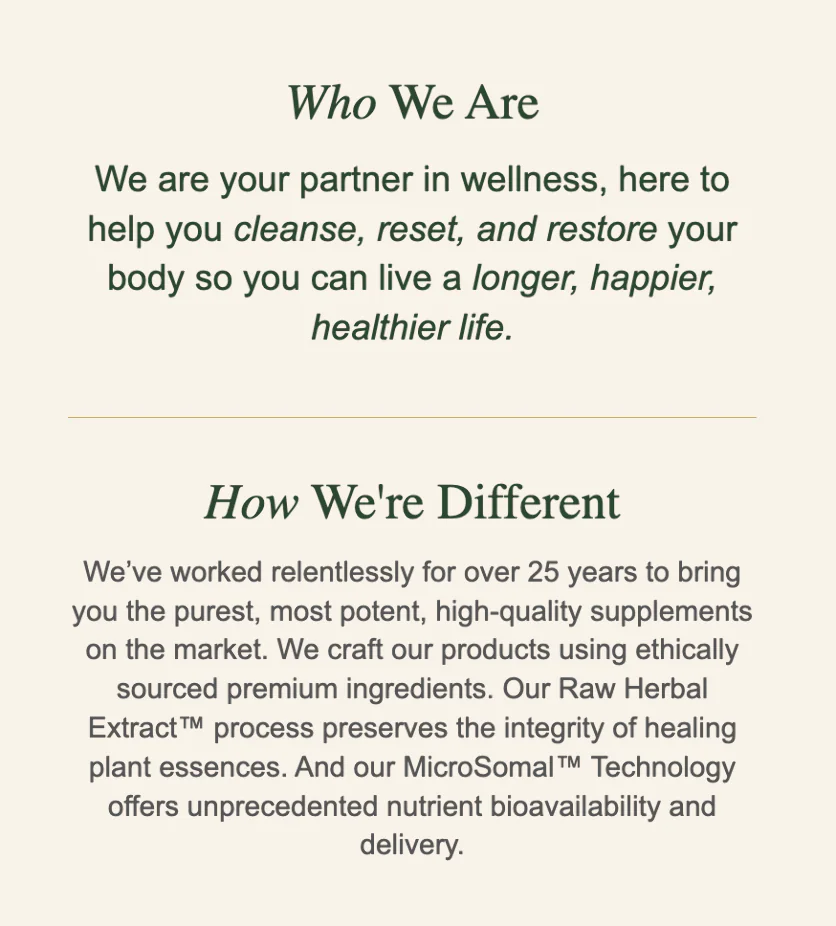Learn how Global Healing uses education-first marketing to transform skeptical shoppers into brand advocates who willingly pay premium prices
April 10, 2025
Education-First Marketing: How Global Healing Builds Trust Through Knowledge
Would you spend thousands on ads that don’t directly sell your products? Create content where your products are supporting characters, not the stars? Build email sequences that focus on education instead of conversion?
Global Healing, a supplement brand, does exactly that. And it works. In a crowded, competitive market, their education-first approach turns curious shoppers into well-informed buyers—and passionate brand advocates.
Our customers truly understand brand value and willingly buy at full price. We only run two promotions all year—Earth Day and Black Friday—and still, we rarely hear price objections.
Our retention is unheard of. Customers start with a flagship product like Oxy Powder, then come back to order four, five, six more products. They understand our quality, they subscribe—without any auto-enrollment tricks. Over 30% of orders are subscriptions that were manually enrolled.
Executive Summary
Education-first marketing means teaching before selling. Global Healing implements this through five key steps:
- Invest in authentic content: Develop extensive educational resources—like 1,700 human-written articles and behind-the-scenes content—without focusing on the hard sell.
- Distribute knowledge across multiple channels: Share educational content through 13 sales channels, including paid ads that prioritize education over conversion.
- Personalize the learning journey: Tailor content based on search behavior, purchase history, and customer signals to keep education relevant and useful.
- Focus on relationship quality over volume: Target customers who appreciate education. These customers stick around—and become your best advocates.
- Make education a core metric: Shift KPIs from traditional sales to "customers reached with information" as a company-wide goal.
The results? Premium pricing without pushback, exceptional customer loyalty, and 30% of all e-сommerce orders coming from opt-in subscribers, without auto-enrollment.
3 Reasons to Consider Education-First Marketing
If your business vertical struggles with trust, skepticism, or a complicated product, education-first marketing might be exactly what you need. Here’s where this strategy really shines:
1. Your industry is new
Emerging categories often suffer from one big problem: no one knows what’s real. In a sea of vague claims and noisy competitors, education can be your clearest differentiator.
We’re in supplements, vitamins, detoxes—there’s a lot out there that’s overwhelming and, honestly, inaccurate. ‘Natural' is a term everyone throws around without much meaning.
That’s why we focus on transparency. We break down our ingredient lists, explain where everything comes from, and show exactly how our products are made. Global Healing has a true commitment to the highest quality and transparency. When your product is made for consumption, this “behind the scenes" perspective goes a long way with your customers.
2. Your customers are (rightfully) skeptical
In industries where customers have been burned before, education helps rebuild trust—and gives you the space to prove you’re different.
When customers find us after investing money on other products with no positive outcome, they’re shocked to learn many of those brands are made in the same few facilities. We take pride in showing that we own our manufacturing supply chain and create our own formulations. That difference is visible, and when they understand it, they trust it.
3. Your product is complex or has hidden value
Premium products often come with details that aren’t obvious on a product page. Education brings that value to light—and helps justify the price point.
We don’t compete on price because our process is fundamentally different. We own our manufacturing facility, and there is no plastic anywhere—not even in the paint or the flooring. The design of our spaces is incredibly intentional from concept to completion, we prioritize bioavilability, purity, and potency in every product.
Once customers see that level of care, they get it—and they’re happy to pay full price. For us, the value is in the research, sourcing, manufacturing, and care that is poured into every product that leaves our facility.
The common thread here is trust. Education-first marketing works because it closes the trust gap. By leading with useful, honest information instead of a sales pitch, you can build credibility that turns into loyalty, referrals, and pricing power.
How to Implement Education-First Marketing
Building an education-first strategy isn’t just a marketing task—it’s an organizational commitment. Here's how Global Healing implemented their approach, with practical steps you can adapt for your business:
Step 1: Invest Heavily in Content Creation
Educational content isn't cheap—this is the hardest part. But if you can commit to it, the payoff is a loyal audience that understands your value and happily pays full price.
We’ve published over 1,700 blog articles—all written by real people, not AI. Yes, we still have a human being sit down and research a topic—unheard of in 2025!
But we go even further. I’m sending my social media specialist to our Arizona facility to film actual employees making the products. From raw ingredients to the final bottle, customers get a transparent look at exactly what goes into what they’re buying.
When customers see how it’s done, they know we’re serious about quality.

Global Healing's extensive blog library includes over 1,700 articles, all created by in-house researchers, not AI
The surprising part? Many of these articles don't even mention Global Healing's products. They focus on ingredients, health topics, and industry education. One post might explain how certified organic manufacturing works; another might break down the role of cinnamon in berberine.
Yes, it’s a big upfront investment. But this kind of content doesn’t expire. It works day after day to build trust, attract search traffic, and convert high-value customers—without discounts or gimmicks.
Step 2: Distribute Education Across Every Channel
Great content doesn’t work if no one sees it. That's why Global Healing takes a strategic, multi-channel approach to distributing educational content across every point of customer interaction.
I pay for ads that don’t even land on product pages. I’m literally paying to educate potential customers—because they’re our high-value audience. I am not just targeting anyone with a phone and a pulse.
With 13 active sales channels—including their website, email, SMS, social media, marketplaces like Amazon, and retail partners—Global Healing makes sure customers encounter consistent, informative messaging wherever they go.
Our emails might highlight our fulfillment team or explain where a specific ingredient—say, one of our herbs—was grown in France. We start building trust before we ever ask for a sale. Our product pages are intentionally loaded with information. We show full labels, sourcing details, and manufacturing methods. Even if someone lands directly on a product page, they’re getting an education before they ever see the 'Add to Cart' button.
Education-first marketing only works when it’s visible—consistently, everywhere.

Fragments of Global Healing's onboarding emails

Fragments of Global Healing's onboarding emails
Step 3: Personalize Education Based on Customer Signals
Global Healing adapts educational content to match customer’s behavior, intent, and stage of the journey.
If someone searches for cayenne pepper on our site, they enter a flow about natural metabolism support. If they’re buying gut health products, they get content about balancing digestion through diet and lifestyle.
If someone searches for cayenne pepper on our site, they enter a flow about natural metabolism support. If they’re buying gut health products, they get content about balancing digestion through diet and lifestyle.
If someone’s a one-time buyer, we send education about consistency—how results build over time. If they’re already subscribed, we send deeper product education or info on complementary products.
We’re always teaching—not just selling.
This kind of personalization makes customers feel understood—and more importantly, it helps them make better decisions. You’re not just recommending a product. You’re guiding them to the right solution, at the right moment, with real information they can use.
Step 4: Focus on Quality Relationships Over Quantity
Education-first marketing doesn’t bring in everyone—it brings in the right ones. And that’s exactly how Global Healing likes it..
Our ideal customer is the subscriber—someone who loves our brand, becomes an advocate, and shares it organically. Even when we’re acquiring new customers, I don’t need quantity—I need quality. We build our lists using lookalike audiences and purchase patterns. We’re never just targeting the general public.
One of our major KPIs isn’t how many new customers we gain—but how valuable each one is.
To go deeper, Global Healing is building a community around the brand—beyond products, beyond promotions.
We’ve hired someone whose full-time role is to engage our audience through events and loyalty programs.
We want customers to feel part of something bigger than just transactions. They attend virtual events, connect with others on a health journey, and get access to our experts. The goal is to not only continue customer education, but to build and nurture a community in our space.
The result: a customer base that’s intentional by design—but delivers big on loyalty and lifetime value
Step 5: Make Education a Company-Wide Metric
Perhaps the boldest move in Global Healing's approach is how they define success. Sales aren’t the top performance metric. Education is.
Global Healing’s number one KPI is customers reached with information. Not sales. Not margin. Every department is measured by how well they educate. With well educated customers and loyal brand advocates, sales and margin will naturally fall into place.
This shared focus brings alignment across the business. Analytics segment customers by educational depth. Operations track shipping by segment, and marketing personalizes content for each group. Everyone speaks the same language—and it’s built around education.
This education culture extends to employees, too:
Every employee visits all of our locations. As a new hire in marketing, I was sent straight to the fulfillment center to understand our packaging decisions, then to the manufacturing facility to see how ingredients are processed. If you’re going to educate customers, you have to start with your own team.
By putting education at the heart of the organization—not just in the marketing deck—Global Healing makes it part of every customer experience.
Implementation Tips for Your Business
Here’s how to apply the Global Healing playbook in your own way:
- Map your audience’s knowledge journey: What matters isn’t just what you know about your products, but what your customers need to know to achieve their goals. Research what questions arise at each stage of their journey.
- Build segment-specific flows: Tailor educational sequences based on interests and behavior.
- Invest in real content and distribute across channels: Hire experts, film your people, write with intent. Make sure this content appears anywhere customers interact with your brand.
- Measure education, not just conversions: Track how many people receive valuable info. Use it as a core success metric.
- Keep buying friction-free: When people are ready to purchase, make it seamless.
Education-first marketing isn’t the quick win. It’s the lasting one. It builds real trust, attracts customers who value quality, and earns the kind of loyalty that sticks.
If your core focus is the people you’re serving, the rest will fall into place.

